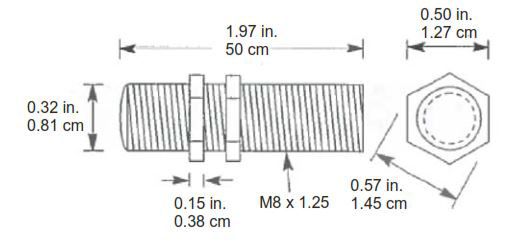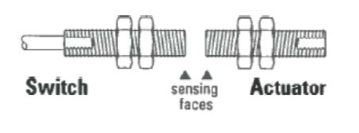How To Install Sentrol GuardSwitch Series 128C Non-Contact Interlock-Position Switch
Edwards Signaling 12th Dec 2022
How To Install Edwards Signaling GuardSwitch Series 128C Non-Contact Interlock-Position Switch
Operation
WARNINGS: To avoid switch failure, determine the actual load of the GE Security switch circuit and take steps to protect the switch from voltage spikes, current inrush and line/load capacitance using the following recommendations:
• Surges from coils, motors, contactors, solenoids and tungsten filaments. Transient protection, such as back-to-back zener diodes (Transorb) or an RC network, is recommended for such loads to ensure that maximum ratings of the switch are not exceeded.
• Line capacitance and load capacitance. An in-line resistor can be added in series immediately before the load to limit the inrush current. The resistor can only be added in series with the last wire just before the load. The voltage drop and the power rating of the resistor must also be calculated as follows:
Voltage drop = l · R Watt = l² · R
(l = maximum continuous current of the load)
To verify Sentrol switch operation with an ohmmeter:
For a normally open Interlogix switch, the meter will read high resistance with the actuator away (0L or greater than 10 Mega Ohms). The meter will read a low resistance with the actuator in sense range (less than 1 Ohm). You will see the opposite reading for a normally closed switch.
Installation
To install the device:
1. Determine a suitable mounting location using the following guidelines:
• The switch and actuator must be within the Listed sense range. See Table 2.
• The sense ranges are based on the switch and actuator being aligned so that the sensing surfaces are face to face. See Figure 2.
Important: When mounting in proximity to ferrous material (steel), the sense range can be reduced 50 percent minimum depending on the shape and type of the material. Test the switch in specific applications to determine the actual sense range.
• When mounting on a ferrous material (steel), a 1/4 in. non- ferrous (plastic or aluminum) spacer may be used around the actuator and switch to restore most of the lost gap.
• When mounting on a hinged gate or door, mount the switch and actuator 6 inches away from the hinges to achieve maximum movement.
• The switch and actuator must move in one of the approved directions. See Figure 3.
• The actuator can be mounted at a 90 degree rotation to the switch.
• Do not mount for parallel actuation. An on-off-on signal may result when the actuator passes by the switch.
2. Mount the switch on the stationary frame of the machine and connect the electrical wiring. When mounting the switch on an ungrounded machine, connect the ground lead to one of the mounting screws.
3. Mount the actuator on the moveable guard, door, or gate.
Caution: Risk of equipment damage. Do not force or hammer. This may damage the switch.
4. Slightly over drill the holes for easy insertion. The switch and actuator should easily slide or screw into the predrilled holes.
Wiring
Figure 1: Dimensions

Figure 2: Position

Figure 3: Barrel Switch mounting configurations

Note: Three configurations are appropriate for recessed interlock applications (end-to-end, side-by-side, perpendicular). Moving the actuator parallel to the switch can result in on/off/on signal if the actuator passes by the switch rather than coming to rest in proximity to it. This is not a recommended configuration for interlock/position applications. The “T” configuration results in non-actuation.
Specifications
Table 1: General specifications
Enclosure - Stainless steel threaded barrel with 2 jam nuts
Dimensions - M8 dia. × 1.25 thread × 50 mm long
Temperature range -40°F to 180°F (-40°C to 80°C)
Environmental - Hermetically sealed contact switch.Sealed in polyurethane.
NEMA rating 1, 2, 3, 4X, 5, 6, 12
Protection class IP 67
Response time - 1 msec
Life cycles - 100,000 under full load; up to 200,000,000 under dry circuit
Contact resistance - 0.2 Ohms
Lead types/ O.D. 22/3 jacketed 0.164 in. (0.41 cm)
22/2 jacketed (J) 0.16 in. (0.41 cm)
UL/CSA All models
WARNING: Each electrical rating is an individual maximum and cannot be exceeded.
| Part Number | Red Wire | White Wire | Load RatingAC/DC | Switching Voltage Maximum AC/DC | Switching Current Maximum AC/DC | Contact Resistance | Lead Length Nominal | Lead Size |
|---|---|---|---|---|---|---|---|---|
| 128c-2n-06(j) | N.C. | N.O. | 15VA/15W | [email protected] [email protected] | 0.5A@30V 0.5A@30V | 0.2 Ohms | 6 ft. (1.8 m) | 22/3 |
| 128c-gn-06(j) | N.C. | - | 15VA/15W | [email protected] [email protected] | 0.5A@30V 0.5A@30V | 0.2 Ohms | 6 ft. (1.8 m) | 22/2 |
| 128c-gn-12(j) | N.C. | - | 15VA/15W | [email protected] [email protected] | 0.5A@30V 0.5A@30V | 0.2 Ohms | 12 ft. (3.6 m) | 22/2 |
| 128c-6n-06(j) | N.O. | - | 25VA/25W | [email protected] [email protected] | 0.7A@35V 1.0A@25V | 0.2 Ohms | 6 ft. (1.8 m) | 22/2 |
| 128c-6n-12(j) | N.O. | - | 25VA/25W | [email protected] [email protected] | 0.7A@35V 1.0A@25V | 0.2 Ohms | 12 ft . (3.6 m) | 22/2 |
| 128c-9n-06(j) | N.O. | - | 50VA/50W | [email protected] [email protected] | 0.7A@71V 1.0A@50V | 0.2 Ohms | 6 ft. (1.8 m) | 22/2 |
| 128c-9n-12(j) | N.O. | - | 50VA/50W | [email protected] [email protected] | 0.7A@71V 1.0A@50V | 0.2 Ohms | 12 ft. (3.6 m) | 22/2 |
Table 2: Ordering/Electrical specifications and wire color codes
Notes:
1. For all 128c models the Black wire is the Common contact.
2. Configure with actuator away from the switch.
| Actuator Options | 128c-2 or 128c-6 | 128c-6 | 128c-9 | Actuator Description | |||
|---|---|---|---|---|---|---|---|
| Make, min. | Break, max. | Make, min. | Break, max. | Make, min. | Break, max. | ||
| 128c-u | 0.25 | 0.8 | 0.15 | 1 | 0.1 | 0.7 | Alnico magnet in M8 x 1.25 x 50 stainless steel threaded barrel with two jam nuts |
| 129-x | 0.45 | 1.1 | 0.35 | 1.35 | 0.25 | 1 | Alnico magnet in M12 x 1 x 70 stainless steel threaded barrel with two jam nuts |
| 1057 | 0.9 | 1.75 | 0.85 | 2.15 | 0.7 | 1.7 | Bare Alnico magnet 3/8 in. dia. x 1-1/2 in. long |
| ind1835 | 0.5 | 0.85 | 0.4 | 1 | 0.3 | 0.8 | Rare earth 0.6 in. dia. x 0.12 in. thick with #4 countersink hole. |
Table 3: Sense range [1]
[1] Proximity of ferrous materials usually reduces the sense range; typically by 50 percent. The shape and type of material cause a wide diversity of effects. Testing is required to determine the actual sense range for specific applications.
12th Dec 2022


